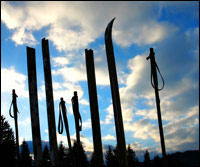With the Olympics starting this week, all eyes are on the slopes of Turin. But skiing and snowboarding could disappear from our collective culture in about 50 years, if global-warming forecasts ring true. In a lot of popular ski areas, there simply won’t be any snow.

It’s all downhill from here.
Photo: stock.xchng.
It’s already happening in parts of Europe: They’re wrapping glaciers in Switzerland, and Scottish Highlands ski areas are being recast as mountain-biking destinations. In the U.S., resorts in the Pacific Northwest got a harbinger last season when a warm winter led to a 78 percent drop in skier visits.
Global warming, of course, will impact practically every aspect of life the world over, and recreational plights won’t be our biggest worry. But right now, the ski industry is the perfect coal-mine canary for its fallout. And while no single industry can reverse climate change, enlightened self-interest is driving ski areas to adopt a wide range of innovative energy measures to prolong their survival — and maybe ours.
Are they doing enough? It depends whom you ask.
Mountain Unrest
The center of the green skiing movement in the U.S. is Aspen, a place not exactly known for reducing consumption of anything. The Aspen Skiing Co., which operates four mountains in the area, first tinted green in 1997, when CEO Patrick O’Donnell — who had previously run Patagonia — hired Auden Schendler as the industry’s first in-house environmental affairs director. Since then, critics and observers ranging from the U.S. Green Building Council to the Natural Resources Defense Council to Plenty magazine, which named Aspen North America’s top eco-ski resort in 2004, have hailed their work as a model for the industry — and for other outdoor-recreation industries as well.
“Our whole environmental program is organized under the umbrella of climate,” says Schendler, who previously worked at the nearby Rocky Mountain Institute. “Climate change should be driving everything we all do.”
For its part, Aspen has enacted a top-to-bottom program to conserve energy and water and reduce greenhouse-gas emissions, incorporating green buildings, a mini-hydroelectric plant, biodiesel-driven groomers, and wind power purchases. This year, the company became the first resort of any kind to join the Chicago Climate Exchange, North America’s first voluntary, legally binding emissions-trading market. Aspen has even set up a consulting business to help other resorts and businesses go green.

A monumental moment.
Photo: iStockphoto.
The $4 billion ski industry “got a wake-up call” in 1998, notes Schendler, when protesters torched Vail. The fact that radical greens would burn a place most people envision as part of an outdoors experience stunned the industry into introspection. Until that point, says Schendler, “there was this perception that the industry must be environmentally friendly because these are all really outdoorsy people … but the reality of it was there was no environmental scrutiny whatsoever.”
Two years later, more than 160 resorts signed a nonbinding charter initiated by the National Ski Areas Association that pledged environmental responsibility. Today, of the 492 ski resorts in the U.S., about 180 participate in the NSAA’s Sustainable Slopes program, which grew out of the charter. Schendler says things are changing, but not enough. “The industry response [to climate change] has largely been to increase snowmaking and increase water storage,” he laments, “not, ‘Let’s lobby hard for legislation and start being more energy efficient.'” As a result, he says, “not much has happened industry-wide.”
Geraldine Link, director of public policy at the Lakewood, Colo.-based NSAA, disagrees. “The industry is taking climate change seriously, and I think we’re doing a lot,” she says. For the last two years, the NSAA has partnered with NRDC on a Keep Winter Cool public-education campaign. The goal is to reach as many of America’s 15 million skiers and snowboarders as possible through public-service announcements and promotional materials. This winter’s big push is selling “cool tags” — mini, $2 versions of alternative-energy certificates, whose proceeds let resorts buy the real thing.
John Steelman, program manager of NRDC’s climate center, says the partnership drew some flak early on from green groups that viewed ski resorts as land-gobbling, energy-sucking enemies, but once he explained it, they backed off. “One of our objectives was to move the issue of climate change beyond the environmental community,” he explains. At the same time, he points out that NRDC’s endorsement does not go past the Keep Winter Cool campaign: “There are areas where we disagree with the ski industry, particularly land use.”
Still, Steelman credits the industry for sending a letter to Sens. John McCain (R-Ariz.) and Joe Lieberman (D-Conn.) last year backing the duo’s climate-change bill; it was signed by 71 resorts in 21 states. “To promote legislation like this is a pretty rare thing for a business association,” he says. “It’s also a pretty brave thing for an industry to try to educate the public on an issue that threatens [its] existence.”
Jiminy Crickets
As time and clime march on, individual owners of both local and mega-destination resorts are working to reduce fossil-fuel dependence and boost awareness of global warming. Brian Fairbank is one of them. The CEO and co-owner of Jiminy Peak in northern Massachusetts, Fairbank is about to invest $2 million — including nearly $600,000 in state grant funds — to make his ski area the first in the country with its own wind turbine. Because of its low elevation, Jiminy is the kind of area that climatologists warn will be the first to lose its snowpack to global warming.

Green skiing? Not exactly.
Photo: iStockphoto.
“We saw the energy crisis coming last July and August,” says Fairbank. “Our energy costs went from $750,000 a year three years ago to $1.45 million last year.” Fairbank says the turbine will generate close to 40 percent of his power needs, paying for itself in about eight years. He points out that all ski areas are at the mercy of a slew of variables, but energy costs can be controlled. “It’s smart for the whole industry to realize that you can eliminate this variable,” he says. “This is an investment in our future, and in stabilizing the financial well-being of our company.” And it’s more than business to Fairbank, who says, “I hope my grandchildren will look at me proudly that I helped reduce our dependence on fossil fuels.”
NSAA’s Link says Jiminy’s move “speaks loudly of the industry’s commitment … there’s been a huge investment in renewables at resorts,” she adds. “Many resorts are using photovoltaic panels, and about 35 resorts now are buying green power.” Jackson Hole, in Wyoming, runs two chairlifts on purchased wind power. Alta, in Utah, took a page from Aspen’s book and built an all-green mid-mountain restaurant. And last year, Buck Hill Ski Area in Burnsville, Minn., bought enough wind power to run 85 percent of its 40 acres.
Once wind power became widely available, says Buck Hill’s general manager Don McClure, deciding to buy it was easy, even though it cost slightly more than conventionally generated electricity. “We’re concerned about climate change,” he says. “We’re also heavily youth oriented, and we think this sets a good example — not to rely so much on traditional energy.”
Mammoth Mountain, a popular resort on the eastern slope of California’s Sierra Nevada, has also embarked on an energy revamp in recent years. Since 2000, the ski area has reduced electricity needs by 9 percent and cut propane use by 70,000 gallons per year. Even with a new gondola up and running this year, the resort uses less energy than it did before the lift’s completion. It has imposed a five-minute idling time limit for vehicles on all of its properties, reduced the number of parking spaces to encourage commuting, and runs biodiesel throughout its operation. “We convinced the town [of Mammoth Lakes] to switch to biodiesel too,” says Lisa Isaacs, Mammoth’s director of environmental programs.
“All the people I talk to in this industry, they’re scared,” Isaacs says. “I’m scared. Global warming trumps everything. If it continues, we won’t even be able to make snow.”
Might as Well Jump
So what does all this mean? Last year, 54 of the resorts participating in the Sustainable Slopes program reported back to NSAA with detailed energy data, and the results are, well, a whole lot better than nothing. Their CO2 reductions for 2005 — from energy savings, green-power purchases, waste reduction and recycling, and vehicle-miles avoided — totaled the equivalent of 87,000 round-trip flights between New York and San Francisco. That would be like shutting down 126,000 ski lifts for a day.
And while climate change isn’t putting new construction projects on ice, it’s changing the way some of them are built. The Aspen Skiing Co. is going ahead with a massive $400 million base village at Snowmass, but Schendler says all the buildings will use at least 30 percent less energy than required by code. At Mammoth, a new lodge is currently in the design phase — but the resort sits on a volcanic cauldron, so the building will tap this geothermal gold-mine.
Even the biggest proponents of these changes acknowledge that none of the measures — not even all of them put together — will reverse global warming. But every little bit helps. Perhaps more to the point, efforts like these are no longer optional for the ski industry. As Isaacs puts it, “We make our living off the environment, so we have to take care of it.”


